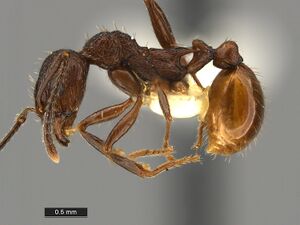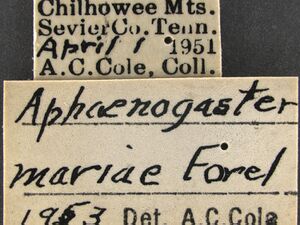Aphaenogaster mariae
| Aphaenogaster mariae | |
|---|---|

| |
| Scientific classification | |
| Kingdom: | Animalia |
| Phylum: | Arthropoda |
| Class: | Insecta |
| Order: | Hymenoptera |
| Family: | Formicidae |
| Subfamily: | Myrmicinae |
| Tribe: | Attini |
| Genus: | Aphaenogaster |
| Species: | A. mariae |
| Binomial name | |
| Aphaenogaster mariae Forel, 1886 | |
This species is arboreal, and has only been collected on trunks of live trees at bait. One nest was observed in a treehole. (DeMarco, 2015)
Identification
Aphaenogaster mariae has the diagnostic character of a starburst of striae (Ellison, et al. 2012) at the base of the gaster. They also have very rugose sculpturing on the mesosoma. (DeMarco, 2015)
Florida
Deyrup (2016) - This rare species has a conspicuous ventral protuberance on the postpetiole and sculpture of coarse, irregular ridges on the mesopleuron and both features are also found in Aphaenogaster tennesseensis. Aphaenogaster mariae is distinguished from tennesseensis and other species of Aphaenogaster by the fine ridges that radiate from the base of the first gastral tergite and cover about a quarter of the tergite.
Keys including this Species
Distribution
Florida
Deyrup (2016) - New York south into Florida, west into Iowa and Kansas (Smith 1979). I have seen only two specimens from Florida, one from Liberty County and the other from Orange County. Both were taken in traps. The type specimen is also from Florida, with the locality unknown.
Latitudinal Distribution Pattern
Latitudinal Range: 44.34° to 30.23°.
| North Temperate |
North Subtropical |
Tropical | South Subtropical |
South Temperate |
- Source: AntMaps
Distribution based on Regional Taxon Lists
Nearctic Region: United States (type locality).
Distribution based on AntMaps
Distribution based on AntWeb specimens
Check data from AntWeb
Countries Occupied
| Number of countries occupied by this species based on AntWiki Regional Taxon Lists. In general, fewer countries occupied indicates a narrower range, while more countries indicates a more widespread species. |

|
Estimated Abundance
| Relative abundance based on number of AntMaps records per species (this species within the purple bar). Fewer records (to the left) indicates a less abundant/encountered species while more records (to the right) indicates more abundant/encountered species. |

|
Biology
The fine ridges that radiate from the base of the first gastral tergite and cover about a quarter of the tergite are also found in other species of myrmicines, and are regularly present in the dacetines, but their significance is unknown. One possibility is that these areas serve as channels and evaporative areas for chemical repellents (Deyrup, 2016).
Florida
Deyrup (2016) - Little is known about the biology of this rare species. Wheeler (1910a) suggested that mariae might be a temporary nest parasite of some other Aphaenogaster, such as Aphaenogaster fulva. He based this on the small size and long propodeal spines of the queen, both characteristics of the apparently related species tennesseensis, which is also thought to be a temporary nest parasite. In Ohio, however, Wesson and Wesson (1940) found mariae "frequently," in oak trees, the nests in branch stubs or in rotten holes in the trunk. The Wessons did not find any other arboreal Aphaenogaster, although they regularly found several other species of arboreal ants. It seems a bit unlikely that they would have missed a species of arboreal Aphaenogaster common enough to serve as the host for mariae. Of course, the nesting ecology of a species of ant is not necessarily constant throughout its range; Aphaenogaster lamellidens seems to be an example of this. In Florida, one specimen was collected in a red maple swamp; the other was probably collected in a hardwood forest.
Castes
Worker
   
| |
| . | Owned by Museum of Comparative Zoology. |
Queen
Images from AntWeb
   
| |
| Queen (alate/dealate). Specimen code casent0173650. Photographer April Nobile, uploaded by California Academy of Sciences. | Owned by CAS, San Francisco, CA, USA. |
Male
The males of this species have yet to be collected.
Nomenclature
The following information is derived from Barry Bolton's Online Catalogue of the Ants of the World.
- mariae. Aphaenogaster mariae Forel, 1886b: xli (w.) U.S.A. (Florida).
- Mackay & Mackay, 2017: 292 (q.m.).
- Combination in Stenamma (Aphaenogaster): Emery, 1895c: 301;
- combination in Aphaenogaster (Attomyrma): Emery, 1921f: 58.
- Status as species: Mayr, 1886d: 443 (in key); Cresson, 1887: 260; Dalla Torre, 1893: 103; Emery, 1895c: 301; Wheeler, W.M. 1906b: 5; Wheeler, W.M. 1910g: 565; Wheeler, W.M. 1916m: 586; Emery, 1921f: 58; Smith, M.R. 1930a: 4; Wheeler, W.M. 1932a: 5; Wesson, L.G. & Wesson, R.G. 1940: 93; Buren, 1944a: 285; Creighton, 1950a: 145; Smith, M.R. 1951a: 796; Carter, 1962a: 6 (in list); Smith, M.R. 1967: 352; Kutter, 1968b: 203; Smith, D.R. 1979: 1361; DuBois & LaBerge, 1988: 137; Deyrup, et al. 1989: 95; Wheeler, G.C., et al. 1994: 302; Bolton, 1995b: 71; Deyrup, 2003: 44; Coovert, 2005: 47; Ellison, et al. 2012: 229; Deyrup, 2017: 50; Mackay & Mackay, 2017: 290 (redescription).
Description
Deyrup (2016) - August Forel named this species for Mary Treat, who sent him a specimen from Florida. Forel named both A. mariae and Aphaenogaster treatae for Mary Treat in the same paper (Forel 1886). I am impressed that she found this species, which I have sought in vain for years.
Mary Treat (1830-1923) was an important self-taught scientist who wrote several books on natural history, including one on butterflies, her work often being published in popular magazines rather than scientific journals. In January, 1879, she published an extensive account of a colony of a slave-making Formica, with detailed descriptions of raids and some preliminary experimental manipulations. Lacking scientific credentials, and perhaps primarily interested in stimulating general interest in the natural history of ants, Treat published her paper in Harper's Monthly Magazine. Treat's observations are still useful and raise some interesting questions, assuming the account is accurate. There are plenty of startling anthropomorphisms, as one might expect for the time, considering that the first volumes of Fabre's Souvenirs Entomologiques (which mark the beginning of our modern understanding of insect behavior) were also published in 1879. Her work was noted by Charles Darwin in his book on insectivorous plants, and the two exchanged letters on the subject. Many of her studies were done in her yard and garden in New Jersey, or in the nearby Jersey Pine Barrens. A patient, intelligent, original observer and excellent writer, she might have been an academic star if she had been born at a time or place when there was less disparagement of what was called "the female intellect."
References
- Carroll, T.M. 2011. The ants of Indiana (Hymenoptera: Formicidae). M.S. thesis, Purdue University.
- Davis, T. 2009. The ants of South Carolina (thesis, Clemson University).
- DeMarco, B.B. 2015. Phylogeny of North American Aphaenogaster species (Hymenoptera: Formicidae) reconstructed with morphological and DNA data. Ph.D. thesis, Michigan State University.
- Deyrup, M.A. 2016. Ants of Florida: Identification and Natural History. CRC Press, 423 pp.
- Emery, C. 1895d. Beiträge zur Kenntniss der nordamerikanischen Ameisenfauna. (Schluss). Zool. Jahrb. Abt. Syst. Geogr. Biol. Tiere 8: 257-360 (page 301, Combination in Stenamma (Aphaenogaster))
- Emery, C. 1921c. Hymenoptera. Fam. Formicidae. Subfam. Myrmicinae. [part]. Genera Insectorum 174A:1-94 94: 1-94 + 7 (page 58, Combination in Aphaenogaster (Attomyrma))
- Forel, A. 1886b. Espèces nouvelles de fourmis américaines. Ann. Soc. Entomol. Belg. 30:xxxviii-xlix. (page xli, worker described)
- Ivanov, K. 2019. The ants of Ohio (Hymenoptera, Formicidae): an updated checklist. Journal of Hymenoptera Research 70: 65–87 (doi:10.3897@jhr.70.35207).
- Kirchner, M., Bertone, M., Blaimer, B. B., Youngsteadt, E. (2023). Colony structure and redescription of males in the rarely collected arboreal ant, Aphaenogaster mariae Forel (Hymenoptera: Formicidae). Proceedings of the Entomological Society of Washington, 125(1), 77-88 (doi:10.4289/0013-8797.125.1.77).
References based on Global Ant Biodiversity Informatics
- Belcher A. K., M. R. Berenbaum, and A. V. Suarez. 2016. Urbana House Ants 2.0.: revisiting M. R. Smith's 1926 survey of house-infesting ants in central Illinois after 87 years. American Entomologist 62(3): 182-193.
- Coovert G. A. 2005. The Ants of Ohio (Hymenoptera: Formicidae). Ohio Biological Survey, Inc. 15(2): 1-207.
- Coovert, G.A. 2005. The Ants of Ohio (Hymenoptera: Formicidae) Ohio Biological Survey Bulletin New Series Volume 15(2):1-196
- Deyrup M., C. Johnson, G. C. Wheeler, J. Wheeler. 1989. A preliminary list of the ants of Florida. Florida Entomologist 72: 91-101
- Deyrup, M. 2003. An updated list of Florida ants (Hymenoptera: Formicidae). Florida Entomologist 86(1):43-48.
- DuBois M. B. 1985. Distribution of ants in Kansas: subfamilies Ponerinae, Ecitoninae, and Myrmicinae (Hymenoptera: Formicidae). Sociobiology 11: 153-344
- DuBois M. B. 1985. Distribution of ants in Kansas: subfamilies Ponerinae, Ecitoninae, and Myrmicinae (Hymenoptera: Formicidae). Sociobiology 11: 153-345
- DuBois M. B. 1985. Distribution of ants in Kansas: subfamilies Ponerinae, Ecitoninae, and Myrmicinae (Hymenoptera: Formicidae). Sociobiology 11: 153-346
- Dubois, M.B. and W.E. Laberge. 1988. An Annotated list of the ants of Illionois. pages 133-156 in Advances in Myrmecology, J. Trager
- Emery C. 1895. Beiträge zur Kenntniss der nordamerikanischen Ameisenfauna. (Schluss). Zoologische Jahrbücher. Abteilung für Systematik, Geographie und Biologie der Tiere 8: 257-360.
- Frye J. A., T. Frye, and T. W. Suman. 2014. The ant fauna of inland sand dune communities in Worcester County, Maryland. Northeastern Naturalist, 21(3): 446-471.
- Ivanov, K. 2019. The ants of Ohio (Hymenoptera, Formicidae): an updated checklist. Journal of Hymenoptera Research 70: 65–87.
- Ivanov K., L. Hightower, S. T. Dash, and J. B. Keiper. 2019. 150 years in the making: first comprehensive list of the ants (Hymenoptera: Formicidae) of Virginia, USA. Zootaxa 4554 (2): 532–560.
- Lynch J. F. 1988. An annotated checklist and key to the species of ants (Hymenoptera: Formicidae) of the Chesapeake Bay region. The Maryland Naturalist 31: 61-106
- MacGown J. A., J. G. Hill, R. L. Brown, T. L. Schiefer, J. G. Lewis. 2012. Ant diversity at Noxubee National Wildlife Refuge in Oktibbeha, Noxubee, and Winston Counties, Mississippi. Mississippi Agricultural and Forestry Experiment Station Bulletin 1197: 1-30
- MacGown J. A., J. G. Hill, and R. L. Brown. 2010. Native and exotic ant in Mississippi state parks. Proceedings: Imported Fire Ant Conference, Charleston, South Carolina, March 24-26, 2008: 74-80.
- MacGown J. A., and R. L. Brown. 2006. Survey of the ants (Hymenoptera: Formicidae) of the Tombigbee National Forest in Mississippi. Journal of the Kansas Entomological Society 79(4):325-340.
- MacGown, J.A. and R.L. Brown. 2006. Observations on the High Diversity of Native Ant Species Coexisting with Imported Fire Ants at a Microspatial Scale in Mississippi. Southeastern Naturalist 5(4):573-586
- MacGown, J.A. and R.L. Brown. 2006. Survey of the ants (Hymenoptera: Formicidae) of the Tombigbee National Forest in Mississippi. Journal of the Kansas Entomological Society 79(4):325-340.
- MacGown, J.A., J.G. Hill, R.L. Brown and T.L. 2009. Ant Diversity at Noxubee National Wildlife Refuge in Oktibbeha, Noxubee, and Winston Counties, Mississippi Report #2009-01. Schiefer. 2009.
- Munsee J. R. 1968. Nine species of ants (Formicidae) recently recorded from Indiana. Proc. Indiana Acad. Sci. 77: 222-227.
- Van Pelt A., and J. B. Gentry. 1985. The ants (Hymenoptera: Formicidae) of the Savannah River Plant, South Carolina. Dept. Energy, Savannah River Ecology Lab., Aiken, SC., Report SRO-NERP-14, 56 p.
- Wesson L. G., and R. G. Wesson. 1940. A collection of ants from southcentral Ohio. American Midland Naturalist 24: 89-103.
- Wheeler G. C., J. N. Wheeler, and P. B. Kannowski. 1994. Checklist of the ants of Michigan (Hymenoptera: Formicidae). The Great Lakes Entomologist 26(4): 297-310
- Wheeler, G.C., J. Wheeler and P.B. Kannowski. 1994. CHECKLIST OF THE ANTS OF MICHIGAN (HYMENOPTERA: FORMICIDAE). Great Lakes Entomologist 26:1:297-310


